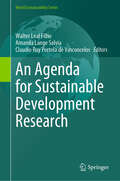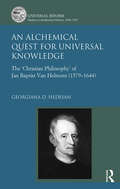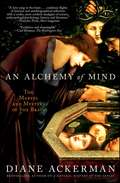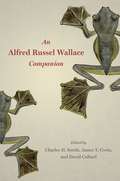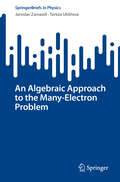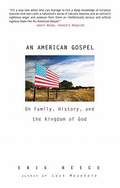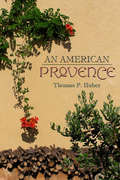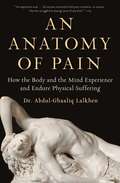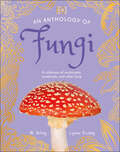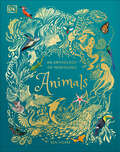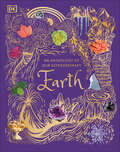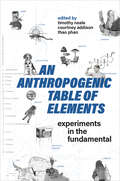- Table View
- List View
An Adventurer's Guide to Number Theory (Dover Books On Mathematics Ser.)
by Richard FriedbergIn this delightful guide, a noted mathematician and teacher offers a witty, historically oriented introduction to number theory, dealing with properties of numbers and with numbers as abstract concepts. Written for readers with an understanding of arithmetic and beginning algebra, the book presents the classical discoveries of number theory, including the work of Pythagoras, Euclid, Diophantus, Fermat, Euler, Lagrange and Gauss.Unlike many authors, however, Mr. Friedberg encourages students to think about the imaginative, playful qualities of numbers as they consider such subjects as primes and divisibility, quadratic forms and residue arithmetic and quadratic reciprocity and related theorems. Moreover, the author has included a number of unusual features to challenge and stimulate students: some of the original problems in Diophantus' Arithmetica, proofs of Fermat's Last Theorem for the exponents 3and 4, and two proofs of Wilson's Theorem.Readers with a mathematical bent will enjoy and benefit from these entertaining and thought-provoking adventures in the fascinating realm of number theory. Mr. Friedberg is currently Professor of Physics at Barnard College, where he is Chairman of the Department of Physics and Astronomy.
An Agenda for Sustainable Development Research (World Sustainability Series)
by Walter Leal Filho Amanda Lange Salvia Claudio Ruy Portela de VasconcelosThis book involves establishing a set of priorities and a roadmap that can guide scholarly and practical efforts towards sustainability goals. It encourages collaboration across disciplines to address complex sustainability issues that span social, economic, and environmental domains. It also supports the development of robust methodologies for conducting research, including quantitative, qualitative, and mixed methods approaches. But despite the importance of and the need for an agenda for sustainable development research, many efforts are isolated and thematically disconnected. Also, it is difficult to find information on how sustainability research is being undertaken and on the wide range of methods being used. Against this backdrop and in order to facilitate a broad discussion on the contribution of sustainable development research, this book is being produced. The book gathers inputs from universities and research organisations working on matters related to sustainable development research in a variety of contexts. It also provides a platform for the dissemination of information on the latest initiatives, paving the way for technology transfer and networking. Furthermore, the book intends to provide a fertile basis upon which universities, research centres, and practitioners may cooperate more closely in this key area. Last but not least, a further aim of the book is to present methodological approaches and experiences deriving from case studies and projects, which aim to show how sustainability research may be implementing across a range of disciplines. Thanks to its scope and interdisciplinarity, this books makes an excellent reading to everyone interested on sustainability research.
An Alchemical Quest for Universal Knowledge: The ‘Christian Philosophy’ of Jan Baptist Van Helmont (1579-1644) (Universal Reform: Studies in Intellectual History, 1550-1700)
by Georgiana D. HedesanHistory of science credits the Flemish physician, alchemist and philosopher Jan Baptist Van Helmont (1579-1644) for his contributions to the development of chemistry and medicine. Yet, as this book makes clear, focussing on Van Helmont's impact on modern science does not do justice to the complexity of his thought or to his influence on successive generations of intellectuals like Robert Boyle or Gottfried Leibniz. Revealing Van Helmont as an original thinker who sought to produce a post-Scholastic synthesis of religion and natural philosophy, Georgiana Hedesan reconstructs his ambitious quest for universal knowledge as it emerges from the text of the Ortus medicinae (1648). Published after Van Helmont's death by his son, the work can best be understood as a compilation of finished and unfinished treatises, the historical product of a life unsettled by religious persecution and personal misfortune. The present book provides a coherent account of Van Helmont's philosophy by analysing its main tenets. Divided into two parts, the study opens with a background to Van Helmont's concept of an alchemical Christian philosophy, demonstrating that his outlook was deeply grounded in the tradition of medical alchemy as reformed by Theophrastus von Hohenheim, called Paracelsus (1493-1541). It then reconstitutes Van Helmont's biography, while giving a historical dimension to his intellectual output. The second part reconstructs Van Helmont's Christian philosophy, investigating his views on God, nature and man, as well as his applied philosophy. Hedesan also provides an account of the development of Van Helmont's thought throughout his life. The conclusion sums up Van Helmont's intellectual achievement and highlights avenues of future research.
An Alchemy of Mind: The Marvel and Mystery of the Brain
by Diane AckermanThe most ambitious and enlightening work to date from the bestselling author of A Natural History of the Senses, An Alchemy of Mind combines an artist's eye with a scientist's erudition to illuminate, as never before, the magic and mysteries of the human mind.Long treasured by literary readers for her uncommon ability to bridge the gap between art and science, celebrated scholar-artist Diane Ackerman returns with the book she was born to write. Her dazzling new work, An Alchemy of Mind, offers an unprecedented exploration and celebration of the mental fantasia in which we spend our days -- and does for the human mind what the bestselling A Natural History of the Senses did for the physical senses.Bringing a valuable female perspective to the topic, Diane Ackerman discusses the science of the brain as only she can: with gorgeous, immediate language and imagery that paint an unusually lucid and vibrant picture for the reader. And in addition to explaining memory, thought, emotion, dreams, and language acquisition, she reports on the latest discoveries in neuroscience and addresses controversial subjects like the effects of trauma and male versus female brains. In prose that is not simply accessible but also beautiful and electric, Ackerman distills the hard, objective truths of science in order to yield vivid, heavily anecdotal explanations about a range of existential questions regarding consciousness, human thought, memory, and the nature of identity.
An Alfred Russel Wallace Companion
by Charles H. SmithAlthough Alfred Russel Wallace (1823–1913) was one of the most famous scientists in the world at the time of his death at the age of ninety, today he is known to many as a kind of “almost-Darwin,” a secondary figure relegated to the footnotes of Darwin’s prodigious insights. But this diminution could hardly be less justified. Research into the life of this brilliant naturalist and social critic continues to produce new insights into his significance to history and his role in helping to shape modern thought. Wallace declared his eight years of exploration in southeast Asia to be “the central and controlling incident” of his life. As 2019 marks one hundred and fifty years since the publication of The Malay Archipelago, Wallace’s canonical work chronicling his epic voyage, this collaborative book gathers an interdisciplinary array of writers to celebrate Wallace’s remarkable life and diverse scholarly accomplishments. Wallace left school at the age of fourteen and was largely self-taught, a voracious curiosity and appetite for learning sustaining him throughout his long life. After years as a surveyor and builder, in 1848 he left Britain to become a professional natural history collector in the Amazon, where he spent four years. Then, in 1854, he departed for the Malay Archipelago. It was on this voyage that he constructed a theory of natural selection similar to the one Charles Darwin was developing, and the two copublished papers on the subject in 1858, some sixteen months before the release of Darwin’s On the Origin of Species. But as the contributors to the Companion show, this much-discussed parallel evolution in thought was only one epoch in an extraordinary intellectual life. When Wallace returned to Britain in 1862, he commenced a career of writing on a huge range of subjects extending from evolutionary studies and biogeography to spiritualism and socialism. An Alfred Russel Wallace Companion provides something of a necessary reexamination of the full breadth of Wallace’s thought—an attempt to describe not only the history and present state of our understanding of his work, but also its implications for the future.
An Algebraic Approach to the Many-Electron Problem (SpringerBriefs in Physics)
by Jaroslav Zamastil Tereza UhlířováThis book presents an algebraic approach to the coupled cluster method for many-electron systems, pioneered by Josef Paldus. Using field methods along with an algebraic, rather than diagrammatic, approach facilitates a way of deriving the coupled cluster method which is readily understandable at the graduate level. The book begins with the notion of the quantized electron field and shows how the N-electron Hamiltonian can be expressed in its language. This is followed by introduction of the Fermi vacuum and derivation of the Hartree-Fock equations along with conditions for stability of their solutions. Following this groundwork, the book discusses a method of configuration interaction to account for dynamical correlations between electrons, pointing out the size-extensivity problem, and showing how this problem is solved with the coupled cluster approach. This is followed by derivation of the coupled cluster equations in spin-orbital form. Finally, the book explores practical aspects, showing how one may take advantage of permutational and spin symmetries, and how to solve coupled-cluster equations, illustrated by the Hubbard model of benzene, the simplest quasi-realistic model of electron correlation.
An Amateur's Guide to Observing and Imaging the Heavens
by Ian MorisonAn Amateur's Guide to Observing and Imaging the Heavens is a highly comprehensive guidebook that bridges the gap between the beginners' and hobbyists' books and the many specialised and subject-specific texts for more advanced amateur astronomers. Written by an experienced astronomer and educator, the book is a one-stop reference providing extensive information and advice about observing and imaging equipment, with detailed examples showing how best to use them. In addition to providing in-depth knowledge about every type of astronomical telescope and highlighting their strengths and weaknesses, two chapters offer advice on making visual observations of the Sun, Moon, planets, stars and galaxies. All types of modern astronomical imaging are covered, with step-by-step details given on the use of DSLRs and web-cams for solar, lunar and planetary imaging and the use of DSLRs and cooled CCD cameras for deep sky imaging.
An American Bestiary
by Jack SchaeferIn a series of leisurely and loving portraits, Jack Schaefer describes a whole ark-full of creatures great and small, who mostly live beyond the din of traffic and the glare of city lights, from the industrious pika, whose sophisticated stockpiling permits him to live in comfort on the desolate rockslides of the high Rockies, to the magnificent pronghorn, whose very appearance represents a perfection of successful adaptation. The book is packed with a thousand bits of information, much of it surely unfamiliar even to the well-read naturalist: the special conditions of a bat's pregnancy, the subterranean architecture of the gopher, the seasonal frustrations of the stolid porcupine. But more important is the overall warmth and geniality of the author's vision--one would like to call it his humanity, but, alas, at the present stage of our development "animality" seems a more appropriate word. In any case, the reader will end up a better mammal, and perhaps even a wiser and more understanding human being.
An American Gospel
by Erik ReeceFrom the award-winning author of Lost Mountain, a stirring work of memoir, spiritual journey, and historical inquiry. At the age of thirty-three, Erik Reece's father, a Baptist minister, took his own life, leaving Erik in the care of his grandmother and his grandfather-also a fundamentalist Baptist preacher, and a pillar of his rural Virginia community. While Erik grew up with a conflicted relationship with Christianity, he unexpectedly found comfort in the Jefferson Bible. Inspired by the text, he undertook what would become a spiritual and literary quest to identify an "American gospel" coursing through the work of both great and forgotten American geniuses, from William Byrd to Walt Whitman to William James to Lynn Margulis. The result of Reece's journey is a deeply intimate, stirring book about personal, political, and historical demons-and the geniuses we must call upon to combat them. .
An American Plague: The True and Terrifying Story of the Yellow Fever Epidemic of 1793
by Jim MurphyNational Book Award Finalist: An account of the disease that ravaged eighteenth-century Philadelphia, written and illustrated for young readers. 1793, Philadelphia: The nation&’s capital and the largest city in North America is devastated by an apparently incurable disease, cause unknown… This dramatic narrative describes the illness known as yellow fever and the toll it took on the city&’s residents, relating the epidemic to the social and political events of the day and eighteenth-century medical beliefs and practices. Drawing on first-hand accounts, Jim Murphy spotlights the heroic role of Philadelphia&’s free blacks in combating the disease, and the Constitutional crisis President Washington faced when he was forced to leave the city—and all his papers—to escape the deadly contagion. The search for the fever's causes and cure provides a suspenseful counterpoint to this riveting true story of a city under siege. Winner of multiple awards, this thoroughly researched book offers a look at the conditions of cities at the time of our nation&’s birth, and draws timely parallels to modern-day epidemics. &“A lavishly illustrated book, containing maps, newspaper columns and period illustrations…unflinchingly presents the horrors of the event as well as its heroes.&”—The New York Times &“Pair this work with Laurie Halse Anderson&’s wonderful novel Fever 1793 and you&’ll have students hooked on history.&”—School Library Journal &“History, science, politics, and public health come together in this dramatic account of the disastrous yellow fever epidemic that hit the nation&’s capital more than 200 years ago.&”—Booklist
An American Provence
by Thomas P. Huber"I have talked about luscious wines and succulent fruit and exquisite dinners. But there may be no more evocative experience of the two valleys than the smell of new-mown hay in the fields at dusk. If a person were to close their eyes, they could not tell if they were in Provence or the North Fork Valley. That sweet, earthy odor is part of the beauty of these places." -From An American Provence In this poetic personal narrative, Thomas P. Huber reflects on two seemingly unrelated places-the North Fork Valley in western Colorado and the Coulon River Valley in Provence, France-and finds a shared landscape and sense of place. What began as a simple comparison of two like places in distant locations turned into a more complex, interesting, and personal task. Much is similar-the light, the valleys, the climate, the agriculture. And much is less so-the history, the geology, the physical makeup of villages. Using a geographer's eye and passion for the land and people, Huber examines the regions' similarities and differences to explore the common emotional impact of each region. Part intimate travelogue and part case study of geography in the real world, An American Provence illuminates the importance sense of place plays in who we are.
An Analytical Mechanics Framework for Flow-Oscillator Modeling of Vortex-Induced Bluff-Body Oscillations (Solid Mechanics and Its Applications #260)
by Haym Benaroya Sohrob Mottaghi Rene GabbaiThis self-contained book provides an introduction to the flow-oscillator modeling of vortex-induced bluff-body oscillations. One of the great challenges in engineering science also happens to be one of engineering design – the modeling, analysis and design of vibrating structures driven by fluid motion. The literature on fluid–structure interaction is vast, and it can be said to comprise a large fraction of all papers published in the mechanical sciences. This book focuses on the vortex-induced oscillations of an immersed body, since, although the importance of the subject has long been known, it is only during the past fifty years that there have been concerted efforts to analytically model the general behavior of the coupling between vortex shedding and structural oscillations. At the same time, experimentalists have been gathering data on such interactions in order to help define the various regimes of behavior. This data is critical to our understanding and to those who develop analytical models, as can be seen in this book. The fundamental bases for the modeling developed in this book are the variational principles of analytical dynamics, in particular Hamilton’s principle and Jourdain’s principle, considered great intellectual achievements on par with Newton’s laws of motion. Variational principles have been applied in numerous disciplines, including dynamics, optics and quantum mechanics. Here, we apply variational principles to the development of a framework for the modeling of flow-oscillator models of vortex-induced oscillations.
An Anatomy of Pain: How the Body and the Mind Experience and Endure Physical Suffering
by Dr. Abdul-Ghaaliq LalkhenAn illuminating, authoritative, and in-depth examination of the fascinating science behind pain and the complexities of its treatment—from one of the internationally leading doctors in pain management.Pain is a universal human experience, but we understand very little about the mechanics behind it. We hurt ourselves, we feel pain, we seek help from a professional or learn to avoid certain behaviors that cause pain. But the story of what goes on in our body is far from simple. Even medical practitioners themselves often fail to grasp the complexities between our minds and bodies and how they interact when dealing with pain stimulus. Throughout history we&’ve tried to prevent and mediate the effects of pain—which has only resulted in a highly medicated population and a booming opiates industry. Written by a medical expert trained as an anesthesiologist, An Anatomy of Pain is the first book to clearly explain the current issues and complexities surrounding the treatment of pain and how society deals with those in pain, as well as how our bodies relate to pain. Common conception still equates pain with tissue damage but that is only a very small part of the story—the organ which produces pain is the brain. Case studies show that a woman who has undergone a c-section reports dramatically less pain than a patient who has had kidney stones removed in a similarly invasive operation. The soldier who drags himself or herself to safety after being shot deals with pain in a remarkably different way from someone suffering a similar injury on a street. The truth is that pain is a complex mix of nerve endings, psychological state, social preconceptions, and situational awareness. Filled with case studies and medical history, this enlightening book offers a crash course in all aspects of pain, from chronic to acute, and walks us through the current landscape of pain treatments—from medication (including opioids) to electrical nerve stimulation. Whether it&’s a mild ache or severe discomfort, we all encounter pain in our lives and this important and illuminating book allows us to master the art of caring and coping with an experience that for so many can become all-consuming.
An Animal a Day: 365 Amazing Animals to Take You Through the Year
by Miranda SmithDiscover a fascinating new animal for every day of the year! The perfect gift for animal lovers aged 6 and up.New day, new animal!In this gorgeous calendarized collection, you'll travel through the incredible ecosystems and habitats of our wild planet and meet 365 of the amazing animals that call it home.Dive into the oceans to find whales and giant squid, soar though skies with eagles and snowy owls, race across the African savanna with lions and wildebeest—and so much more. Each day&’s entry is filled with fascinating facts and breathtaking illustrations that bring animals to life. You'll encounter familiar favorites, plus find out new sides to critters you thought you already knew and learn about completely new animals.Packed with engaging info, this book also features information about conservation and how we can protect endangered animals and their environments.It's the ultimate gift for any animal lover, from age 6 to 106!
An Anthology of Christmas
by Auriol BishopCelebrate the natural wonders of Christmas in this gorgeous gift book packed with stunning photography and festive illustrations.The ninth book in the bestselling Children’s Anthologies series, An Anthology of Christmas explores some of the most amazing Christmassy facts from the natural world.Children aged 7-9 can discover things like why the traditional Christmas tree is usually a pine, spruce, or fir, in this impressive collection that showcases hundreds of fascinating facts about Christmas. Beautiful photography and illustrations complement storybook descriptions, teaching children all about this magical time of year.This magical Christmas anthology for kids offers:A wide selection of Christmas facts featured throughout, accompanied by beautiful photographs and illustrations.The 9th book in the bestselling Children’s Anthologies series, selling more than 130,000 copies in the US.A quality gift book, with metallic foil all over, a ribbon, and striking photographs on every page.Did you know that the custom of kissing under the mistletoe originates from Norse mythology, or that the Christmas wreath has its origins from ancient times when people hung evergreen boughs over their doors and windows?With foil on the cover, gilded edges, and a ribbon for keeping your place, An Anthology of Christmas makes an attractive gift for any child who can’t get enough of the festival of Christmas, but with a unique, quirky approach–and it’s perfect for young readers to explore by themselves or for bedtime stories.More in the seriesAn Anthology of Christmas is part of the beautiful and informative Children’s Anthology series. Complete the series and nurture your child's curiosity as they explore the natural world with The Wonders of Nature, let them walk with the dinosaurs Dinosaurs and other Prehistoric Life, explore the incredible ecosystems and geology of our planet with Earth, or dive into the deep with An Anthology of Aquatic Life.
An Anthology of Exquisite Birds (DK Children's Anthologies)
by Ben HoareSoar through the sky with best-selling author Ben Hoare and discover some of the most exquisite birds on our planet.From the miniature bee hummingbird that flaps its wings 200 times a second, to the oilbird that navigates pitch-black caves using echolocation, this stunning collection showcases more than 90 of the world's most extraordinary birds. Detailed photography is paired with storybook descriptions that will captivate young readers, whether it's finding out about condors and cuckoos or swans and starlings. Features on eggs, feathers, nests, and other key topics explore the enormous variety of avian adaptations. There is also a visual index packed with reference information, including the size and range of each species.With foil on the cover, gilded edges, and a ribbon for keeping your place, An Anthology of Exquisite Birds makes a beautiful gift for any child who is fascinated by birds. It's ideal for young readers to explore by themselves or perfect for bedtime stories.
An Anthology of Fungi: A Collection of 100 Mushrooms, Toadstools and Other Fungi (DK Little Anthologies)
by Lynne Boddy Ali AshbyFind out how to identify, where to spot, and what to know about common woodland mushrooms and rare fungal finds with this beautiful field guide.Transportable in size and crammed with profiles of different mushrooms, An Anthology of Fungi covers toadstool species including fly agaric, porcelain fungus, velvet shank, wood blewit, and crimson waxcap, as well as lichens, brackets, and more.Featuring photographs of striking specimens and illustrations by the artist behind DK’s best-selling Anthology series, as well as plenty of intriguing information, this book will be one to treasure for young nature enthusiasts.
An Anthology of Intriguing Animals (DK Children's Anthologies)
by DKReveal the stories behind your favourite creatures with this awe-inspiring animal book for curious kids aged 6-8.The animal kingdom is so much bigger than young minds can fathom and there is always more to learn. An Anthology of Intriguing Animals is a stunning animal encyclopedia for young readers to explore, with reference pages packed with fascinating information, little learners will be captivated as they discover the facts, stories and myths behind their favourite animals. Whether it&’s where the slow-motion sloth lives, how the plodding pangolin protects itself from predators, or which animal the Ancient Egyptians thought rolled the Sun across the sky, children can learn all sorts of fun animal facts from the storybook descriptions.This beautiful modern bestiary lets you find the animals that interest you and uncover new favourites along the way. From tigers and chameleons to wolves and owls there&’s an animal for everyone in this compendium of creatures. Each type of animal is shown both photographically and illustrated, and children will love poring over the detailed close-up images. The engaging storybook-style descriptions and simple text shed a light on the wonders of wildlife and array of animals, perfect for children aged 6-8 to love and explore for hours on end. Celebrate your child&’s curiosity as they:- Explore detailed photographs and striking illustrations of animals around the world - Reveal fun facts and myths about a wide range of animals - Uncover more than 100 animals, each with stunning images and captivating information.This animal encyclopedia for children is the perfect blend of storybook style text with out of this world illustrations which makes it a fantastic animal book for children who are obsessed with the animal kingdom. Encourage young readers to go on a journey to explore a world of information, making this the ideal first reference book for kids aged 6-8 to enjoy for hours on end, whether reading with the family or reading alone, this fun fact book also doubles up as the perfect gift for curious kids who love to learn. Explore the diversity of the animal kingdom whilst uncovering: -Stunning Jacket Detail: gold foil, holographic foil & metallic gold edges-Stunning photography & illustrations inside-A beautiful book for the whole family to treasure -A quality gift to be passed down through the generationsMore in the SeriesAn Anthology of Intriguing Animals is part of the beautiful and informative Anthology series. Complete the series and nurture your child's curiosity as they explore the natural world with The Wonders of Nature or let them walk with the dinosaurs who ruled the earth before them in Dinosaurs and other Prehistoric Life.
An Anthology of Our Extraordinary Earth (DK Children's Anthologies)
by Cally OldershawExplore the beauty and majesty of planet Earth in this compendium, with more than 100 incredible stories and images.The world is so much more complex than young minds can fathom, from molten-hot rock and smoldering volcanoes to icy glaciers and bubbling springs. This book about the Earth for kids aged 7+ unlocks all the mysteries of our living, breathing planet.An Anthology of Our Extraordinary Earth looks at our constantly changing planet, with striking images and scientific ideas that are easy for children to understand. Starting at the center of the Earth, the book examines each layer in forensic detail: from Earth&’s metallic core, drilling through Earth&’s tough crust until emerging out onto the planet&’s surface, with its lush green rainforests, sparkling oceans, and snow-capped mountains, before sailing up into Earth&’s airy atmosphere.This detailed planet Earth book for kids offers: - More than 100 stories about planet Earth, from snowflakes to cave pearls, each one accompanied by a photograph and delightful illustration.- Creative photography that presents planet Earth in surprising and remarkable ways, capturing nature in action or showing intriguing features up close.- Beautiful gold foil, gilded edges, and a ribbon for keeping your place.- In-depth feature pages that examine each layer of Earth.This striking book won&’t fail to excite budding geologists, geographers, environmentalists, and all-round planet Earth enthusiasts everywhere. With foil on the cover, gilded edges, and a ribbon for keeping your place, this Earth book makes an attractive gift for any child who is fascinated by our planet. With engaging information and absorbing images, this anthology is great for children to explore by themselves or for bedtime stories.More in the SeriesAn Anthology of Our Extraordinary Earth is part of DK&’s beautiful and informative Anthology series. Complete the series and nurture your child's curiosity as they explore the natural world with The Wonders of Nature, let them walk with the dinosaurs who ruled the Earth before them in Dinosaurs and other Prehistoric Life, or dive into the deep with An Anthology of Aquatic Life.
An Anthology of Shells: A Collection of Fascinating Shells from Around the World (DK Little Anthologies)
by Simon AikenA beautiful collection featuring notes, spectacular photos, and illustrations of more than 100 types of shell.A compact version of DK’s bestselling anthology series, An Anthology of Shells is perfect for young nature enthusiasts aged 7-9 for taking on the go.Children can marvel at a wide range of shells from around the world that no collection would be complete without. Learn all about the shell shapes, colors, and textures–and get up close with the snails, crabs, and clams that live in them.This impressive shells anthology for kids offers:The third book in the new compact spin-off of the bestselling Children’s Anthologies series.A magnificent collection of over 100 shell profiles and their creatures from all over the world, from tropical rainforests to icy Antarctic waters.A quality gift book, with metallic foil and striking photographs on every page.An Anthology of Shells pairs photography with storybook descriptions that will captivate young readers, whether it’s marveling at conchs or clams. Featuring photographs of striking formations and illustrations by the artist behind DK’s bestselling Anthology series, as well as plenty of intriguing information, this book will be one to treasure for young conchologists.More in the seriesAnthology of Shells is part of the beautiful, new, and compact Anthology spin-off series. Complete the series and nurture your child's curiosity as they explore geology and earth materials with Rocks and Minerals or mushroom species with the Fungi field guide.
An Anthology of Visual Double Stars
by Andrew James Bob Argyle Mike SwanModern telescopes of even modest aperture can show thousands of double stars. Many are faint and unremarkable but hundreds are worth searching out. Veteran double-star observer Bob Argyle and his co-authors take a close-up look at their selection of 175 of the night sky's most interesting double and multiple stars. The history of each system is laid out from the original discovery to what we know at the present time about the stars. Wide-field finder charts are presented for each system along with plots of the apparent orbits and predicted future positions for the orbital systems. Recent measurements of each system are included which will help you to decide whether they can be seen in your telescope, as well as giving advice on the aperture needed. Double star observers of all levels of experience will treasure the level of detail in this guide to these jewels of the night sky.
An Anthropogenic Table of Elements: Experiments in the Fundamental (Technoscience and Society)
by Timothy Neale Courtney Addison Thao PhanAn Anthropogenic Table of Elements provides a contemporary rethinking of Dmitri Mendeleev’s periodic table of elements, bringing together "elemental" stories to reflect on everyday life in the Anthropocene. Concise and engaging, this book provides stories of scale, toxicity, and temporality that extrapolate on ideas surrounding ethics, politics, and materiality that are fundamental to this contemporary moment. Examining elemental objects and forces, including carbon, mould, cheese, ice, and viruses, the contributors question what elemental forms are still waiting to emerge and what political possibilities of justice and environmental reparation they might usher into the world. Bringing together anthropologists, historians, and media studies scholars, this book tests a range of possible ways to tabulate and narrate the elemental as a way to bring into view fresh discussion on material constitutions and, thereby, new ethical stances, responsibilities, and power relations. In doing so, An Anthropogenic Table of Elements demonstrates through elementality that even the smallest and humblest stories are capable of powerful effects and vast journeys across time and space.
An Anthropologist on Mars
by Oliver SacksTo these seven narratives of neurological disorder Dr. Sacks brings the same humanity, poetic observation, and infectious sense of wonder that are apparent in his bestsellers Awakenings and The Man Who Mistook His Wife for a Hat. These men, women, and one extraordinary child emerge as brilliantly adaptive personalities, whose conditions have not so much debilitated them as ushered them into another reality.
An Anthropologist on Mars: Seven Paradoxical Tales
by Oliver SacksTo these seven narratives of neurological disorder Dr. Sacks brings the same humanity, poetic observation, and infectious sense of wonder that are apparent in his bestsellers Awakenings and The Man Who Mistook His Wife for a Hat. These men, women, and one extraordinary child emerge as brilliantly adaptive personalities, whose conditions have not so much debilitated them as ushered them into another reality.
An Ape’s View of Human Evolution
by Peter AndrewsOur closest living relatives are the chimpanzee and bonobo. We share many characteristics with them, but our lineages diverged millions of years ago. Who in fact was our last common ancestor? Bringing together ecology, evolution, genetics, anatomy and geology, this book provides a new perspective on human evolution. What can fossil apes tell us about the origins of human evolution? Did the last common ancestor of apes and humans live in trees or on the ground? What did it eat, and how did it survive in a world full of large predators? Did it look anything like living apes? Andrews addresses these questions and more to reconstruct the common ancestor and its habitat. Synthesising thirty-five years of work on both ancient environments and fossil and modern ape anatomy, this book provides unique new insights into the evolutionary processes that led to the origins of the human lineage.

